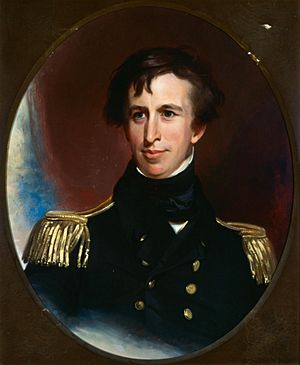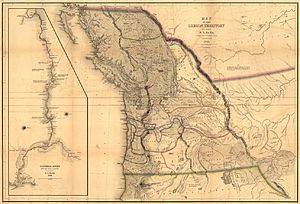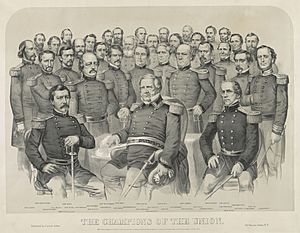Charles Wilkes facts for kids
Quick facts for kids
Charles Wilkes
|
|
|---|---|
 |
|
| Born | April 3, 1798 New York City, U.S.
|
| Died | February 8, 1877 (aged 78) Washington, D.C., U.S.
|
| Known for | |
| Military career | |
| Allegiance | |
| Branch | United States Navy |
| Years | 1818–1866 |
| Rank | Rear Admiral |
| Commands held |
|
| Wars | American Civil War |
| Signature | |
Charles Wilkes (born April 3, 1798 – died February 8, 1877) was an American naval officer and explorer. He is best known for leading the United States Exploring Expedition, 1838-1842. This was a huge journey around the world. During his travels, he faced some challenges and investigations for how he managed his crew.
Later, during the American Civil War (1861–1865), he was in charge of USS San Jacinto. He became famous for the Trent Affair. In this event, he stopped a British ship and took two British people off it. This almost caused a war between the United States and the United Kingdom.
Contents
Charles Wilkes was born in New York City on April 3, 1798. His mother passed away when he was only three years old. He was then raised by his aunt, Elizabeth Ann Seton. She later became the first American-born woman to be recognized as a saint by the Catholic Church.
Charles went to a boarding school and later attended Columbia College. This school is now known as Columbia University. He joined the United States Navy in 1818 as a midshipman. By 1826, he had become a lieutenant.
In 1833, Wilkes surveyed Narragansett Bay. Because of this work, he was put in charge of the Navy's Department of Charts and Instruments. This department later grew into the Naval Observatory and Hydrographic Office.
Exploring the South Seas

In 1838, Charles Wilkes was chosen to lead a major government expedition. Even though he wasn't the most experienced naval officer, he was good at surveying the seas. The goal was to explore and map the Southern Ocean. They also wanted to find and correctly mark the location of any unknown islands.
The US Exploring Squadron was approved by the Congress in 1836. This expedition, often called the "Wilkes Expedition," included many scientists. There were naturalists, botanists, a mineralogist, taxidermists, artists, and a philologist.
They traveled on several ships: USS Vincennes, USS Peacock, the brig USS Porpoise, the store-ship USS Relief, and two schooners, USS Sea Gull and USS Flying Fish.
Journey Around the World
The expedition left Hampton Roads on August 18, 1838. They made stops at the Madeira Islands and Rio de Janeiro. They also visited Tierra del Fuego, Chile, Peru, the Tuamotu Archipelago, Samoa, and New South Wales.
In December 1839, they sailed into the Antarctic Ocean. On January 25, 1840, they reported seeing the coast of an "Antarctic continent" west of the Balleny Islands. They mapped 1500 miles of the Antarctic coastline.
After Antarctica, the expedition visited Fiji and the Hawaiian Islands. In Fiji, there was a difficult conflict. Two sailors, including Wilkes' nephew, were killed while trading for food on Malolo Island. Wilkes reacted strongly, and many Fijians were killed in the incident.
From December 1840 to March 1841, Wilkes and his crew worked on Mauna Loa in Hawaii. They used hundreds of native Hawaiian porters to carry a pendulum to the mountain's top. This was to measure gravity. The conditions on the mountain were very tough, like Antarctica. Many crew members suffered from snow blindness and altitude sickness.

In 1841, Wilkes explored the west coast of North America. This included the Strait of Juan de Fuca, Puget Sound, the Columbia River, San Francisco Bay, and the Sacramento River. He also held the first American Independence Day celebration west of the Mississippi River in Dupont, Washington on July 5, 1841.
The expedition also passed through the Ellice Islands. They visited Funafuti, Nukufetau, and Vaitupu in 1841. The journey ended when they returned to New York on June 10, 1842. They had traveled through the Philippines, the Sulu Archipelago, Borneo, Singapore, Polynesia, and the Cape of Good Hope.
Expedition Outcomes
Wilkes' expedition was the last all-sail naval mission to travel around the world. He covered about 87,000 miles. However, he lost two ships and 28 men during the journey. When he returned, he faced criticism for how he managed his crew. He was found not guilty of most charges, except for illegally punishing some men.
From 1844 to 1861, Wilkes mainly worked on writing the report of the expedition. His book, Narrative of the United States Exploring Expedition, was published in 1844. It had five volumes and an atlas. He also edited the scientific reports, which were 19 volumes.
The Narrative contains interesting information about the cultures and conditions of many places. Wilkes' 1841 Map of the Oregon Territory was made before John Charles Fremont's famous Oregon Trail expedition.
The specimens and artifacts collected by the expedition's scientists became the start of the Smithsonian Institution collection. Wilkes also wrote other important scientific books. These included Western America, including California and Oregon in 1849, and Theory of the Winds in 1856.
Civil War Service
Wilkes was promoted to commander in 1843 and captain in 1855. When the American Civil War began, he was given command of USS San Jacinto. His job was to find the Confederate ship CSS Sumter.
The Trent Affair
During his duties, Wilkes visited the British colony of Bermuda. He stayed in port for nearly a week, which was against British rules for foreign naval vessels. While he was there, his gunboats USS Tioga and USS Sonoma blocked Saint George's harbor. This was an important base for Confederate ships trying to get past blockades.
Wilkes then learned that two Confederate officials, James Murray Mason and John Slidell, were traveling to England on a British ship called RMS Trent. On November 8, 1861, Wilkes ordered his ship, San Jacinto, to stop the Trent. He fired two shots across its bow, forcing it to stop. A group from San Jacinto boarded the Trent and arrested Mason and Slidell. The two diplomats were taken to Fort Warren in Boston.
Wilkes' actions made many people think that a full-scale war between the United States and the United Kingdom was going to happen. The U.S. Congress officially thanked him for his actions. However, President Lincoln later disagreed with Wilkes' actions because of pressure from the British government. Mason and Slidell were released.
Wilkes was later assigned to duty against ships trying to break the blockade in the West Indies. He was promoted to commodore in 1862.
Later Life and Legacy
Charles Wilkes died in Washington, D.C., as a Rear Admiral. In August 1909, his remains were moved to Arlington National Cemetery. His gravestone says that "he discovered the Ant-arctic continent."
Honoring Wilkes
The U.S. Navy has named four ships after Charles Wilkes. These include torpedo boat USS Wilkes (TB-35), destroyer USS Wilkes (DD-67), and destroyer USS Wilkes (DD-441). An oceanographic survey vessel, USS Wilkes (T-AGS-33), was launched in 1969.
Wilkes Land in Antarctica is named after him. In 1923, Wilkes Island, one of the islands around the lagoon at Wake Atoll, was also named for him.
Captain Charles Wilkes Elementary in Bainbridge Island, Washington, is named in his honor. Wilkes Boulevard in Columbia, Missouri, and the Hawaiian plant genus Wilkesia also carry his name.
Dates of Rank
- Midshipman - January 1, 1818
- Lieutenant - April 28, 1826
- Commander - July 13, 1843
- Captain - September 14, 1855
- Retired List - December 21, 1861
- Commodore, Retired List - July 16, 1862
- Rear Admiral, Retired List - August 6, 1866
Images for kids
See also
 In Spanish: Charles Wilkes para niños
In Spanish: Charles Wilkes para niños




